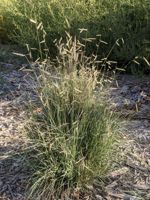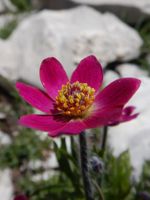Mon-Fri 9am - 5pm Mountain time
Cutleaf Anemone vs Blue Grama Grass
Bouteloua gracilis
Anemone multifida
NOT AVAILABLE THIS SEASON - MIGHT RETURN
NOT AVAILABLE THIS SEASON - MIGHT RETURN
Blue Grama is a native perennial bunchgrass recognized for its blue-green blades and unique seed heads. They grow along one side of the stem and are often compared to eyelashes, eyebrows, or mosquito larvae, which inspired its common names, Eyelash Grass and Mosquito Grass. As the seed heads begin to dry in the fall, they curl, further enhancing the plant’s distinctive appearance. The seeds provide food for birds, and the grass serves as a host plant for certain species of skipper butterflies.
As a warm-season grass, Blue Grama has a slow start in spring and does not actively grow until soil temperatures rise. Its deep roots help with erosion control, and the grass is drought-tolerant once established, thriving even in poor or alkaline soils. It is well-suited for soil stabilization, naturalization, restoration projects, or as an ornamental accent in gardens and landscapes.
Pacific Anemone is a native perennial wildflower with buttercup-like blooms. The flowers can be a variety of colors, including white, pink, and dark red. The deeply cut leaves add a unique texture to the landscape. The flowers bloom from May to August, providing early-season nectar and pollen for insects. They attract a variety of pollinators, including bees and butterflies.
As the flowers fade, they become fluffy white seed heads, which birds often use in their nests. They can spread readily through self-seeding; to limit their spread, regular deadheading is recommended. Tolerant of drought and poor soils, the Pacific Anemone is well suited for wildflower gardens, pollinator gardens, and naturalization projects.

